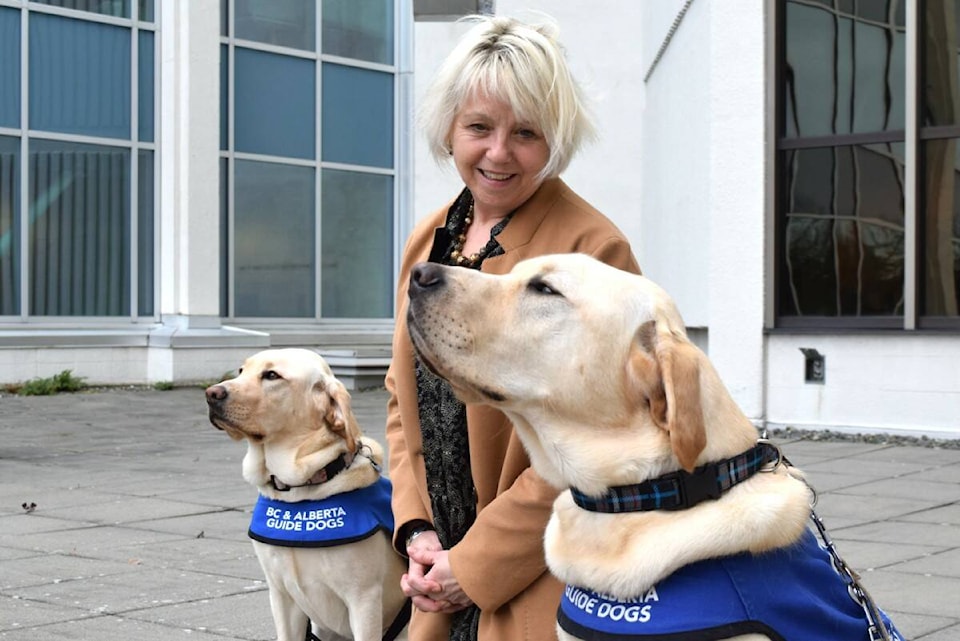Brooklyn Cribdon/For the Peninsula News Review
Do you know the difference between a working dog, emotional support dog, therapy dog, and service dog?
Some may be surprised to learn that these terms are not interchangeable and in fact have very different meanings.
Working dogs are trained for a specific function and assist a human to better do a job-related task, i.e. police, search and rescue, explosive/narcotic search. Emotional support dog is a phrase that Canada adopted from the United States. There is no specific training or certification process for a dog that a doctor may assess and deem to provide emotional support to a person. Therapy dogs, on the other hand, have specific training (i.e. St. John’s Ambulance Therapy Dogs) to support groups of people and be handled by strangers in settings such as hospitals, care homes, and schools.
Finally, service dogs (including guide dogs) are highly specialized and specifically trained to assist a human handler in ways that allow the handler to have as normal a life as possible. Service dogs can help people with many visible and invisible disabilities including PTSD, vision impairment, chronic illness, autism, hearing impairment, seizure detection/response, diabetes, allergies, and physical assistance.
Service dogs are the only dogs that are protected under the Human Rights Code to accompany a human handler everywhere that the public has access to.
Tyson King is the owner-operator of VI K9 service dog training. Unlike basic obedience and behaviour training for pets, service dogs are trained by King for a minimum of 18 months before beginning their life with their handler, upon which another six months of team training occurs.
While there are certain tests that King’s dogs need to pass in order to become certified, these are only provincially specific. At this point in time, there is no national standard for service dogs, or, Animal-Assisted Human Services (AAHS). Without having a national standard, room is left open for dog owners to abuse the system. For instance, in Ontario, service dogs only require a doctor’s note and no specific certification, training, or testing.
King mentions that he’s seen people who have been able to get B.C. certification clearly abusing the system too: from so-called service dogs being allowed to sit on chairs at restaurants, being carried, or behaving poorly, there are many ‘red flags’ that signal when a dog has not been properly trained as a service dog. Service dogs need to be trained specifically for a handler’s needs so King’s team-based training ensures that both the dog and the handler are trained together where the dog and the human learn how to understand and communicate with each other in specific scenarios such as PTSD response or seizure alerts. Not every dog trainer out there can train for every service need. While King is able to train for service dogs for PTSD service, an obedience trainer won’t have that skill set.
“Unfortunately, with the standard that B.C. has put out as their test, you have obedience trainers training people to meet the B.C. standards but because they’re not task-trained, the dog isn’t actually able to do anything” explains King. In regards to the current certification system, King said “It’s just not good enough… People want the luxury of having their pets follow them but not have the proper work.”
Hopefully, a lot of these inconsistencies and abuses of the system will be solved and remedied with the national standard that is currently being drafted and worked on by the Canadian Foundation for Animal Assisted Support Services in conjunction with other service dog stakeholders such as trainers like Tyson King and VI K9.“Legitimate service dogs are an important part of society and [their need] should not be abused.”
When it comes to having a service dog, there is far more that goes into training beyond task-training the dog. King shares that a lot of assessment takes place to ensure the right breed of dog is chosen for the person in need. Some considerations include size of the dog and size of the person’s home, breed characteristics and behaviours, medical or care needs of the handler, lifespan of the breed (VI K9 retires dogs from service at 75 per cent of their life expectancy), and so much more. Moreover, King re-certifies VI K9 dogs every three years to maintain high standards and skill sets, and ensure any changes to the service dog’s skills or the handler’s needs can be identified.
For dogs trained in scent detection for life-threatening conditions, re-certification happens every year to make sure the dog achieves above a 90 per cent success rate.
It may be cute, but when you see a service dog in public, it is important to ignore the dog and let them work. King appreciates that people often want to ask questions, but emphasizes the importance of respecting the handler’s privacy.
To learn more, check out vik9.ca. King encourages people to call if they have questions or want to learn more about service dogs.



